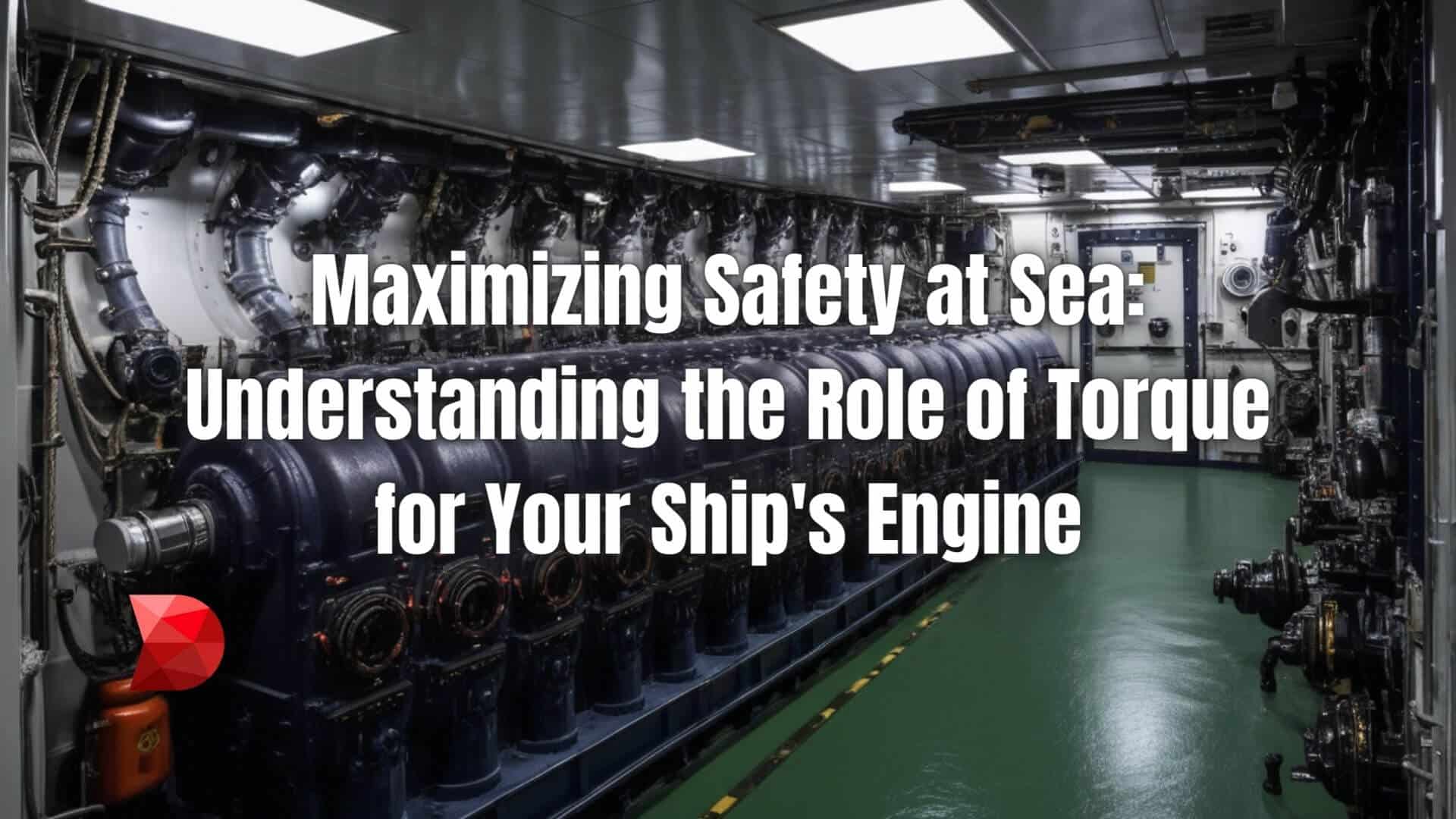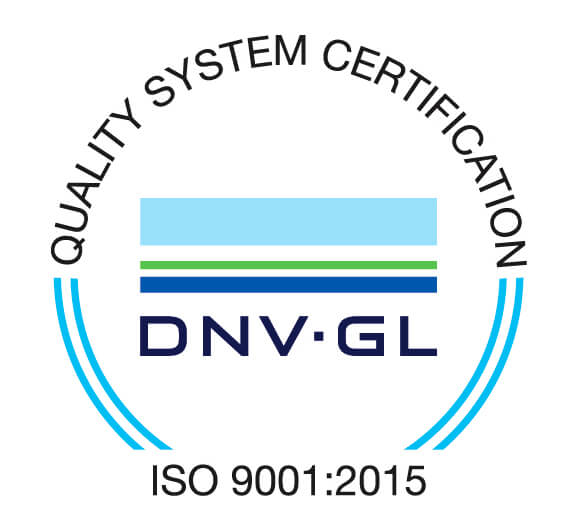Sailing the open seas, whether for commercial or recreational purposes, necessitates a clear emphasis on safety. A crucial aspect of this safety comes from the heart of the ship itself – the engine. Specifically, understanding the role of torque in a ship engine is vital.
Torque, a force that causes rotation, is instrumental in propelling the vessel through the vast oceans. The concept of ‘torque for ship engine’ is more than a technical term. It’s a measure of your vessel’s efficiency, performance, and, ultimately, your safety at sea.
In this article, we delve into the importance of torque for ship engines, exploring how it impacts your journey on the water and ways to enhance its effectiveness for a safer, smoother sailing experience.
Table of Contents
ToggleBasics of Torque in Ship Engines
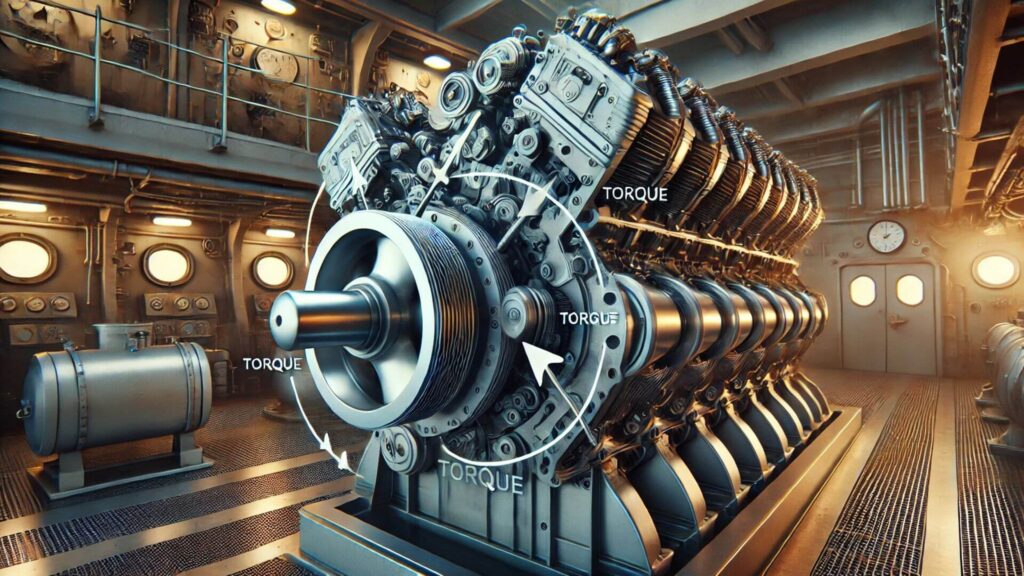
In maritime engineering, torque refers to the rotational force generated by the ship’s engine, which directly influences the propulsion system’s performance. It’s the product of the engine output force and the distance from the force to the turning point or pivot around which the force is applied.
Torque plays a pivotal role in powering propulsion systems. The more torque an engine produces, the more power it can provide to the propeller, thereby driving the ship forward more effectively. Optimizing engine torque is, therefore, critical for ensuring smooth and efficient propulsion, making it a key consideration in maritime operations.
The torque produced by the engine is intrinsically linked to the ship’s overall performance. Torque affects the speed or rotation of the ship’s propeller, which determines the vessel’s speed and maneuverability. High torque at low engine speeds enables the vessel to maintain speed even in adverse conditions, enhancing its overall performance and fuel efficiency.
The generation of torque in ship engines involves several key components: the crankshaft, connecting rod, and piston. These components combine to convert the piston’s linear motion into the crankshaft’s rotary motion, generating torque.
The Impact of Torque on Engine Efficiency
Efficiency is a pivotal factor in maritime operations, and torque plays a significant role in dictating this. Understanding the relationship between torque and fuel efficiency, as well as the impact of torque on the speed and power of a ship, can prove invaluable in optimizing marine operations. This section will also delve into real-world case studies and provide practical tips for enhancing engine efficiency through torque optimization.
Exploring the Relationship between Torque and Fuel Efficiency
Fuel efficiency in ship engines is deeply intertwined with torque. The higher the torque at low engine speeds, the lower the fuel consumption. This is because the engine doesn’t have to work as hard to maintain the ship’s speed, thus using less fuel. An engine with a flat torque curve, which means that it delivers consistent torque across a wide range of engine speeds, is considered more fuel-efficient.
How Torque Affects the Speed and Power of a Ship
The amount of available torque directly influences the power and speed of a ship. High torque can propel a ship forward more effectively, resulting in higher speeds. Moreover, since torque is a measure of rotational force, more torque means more power to overcome resistance (like water currents), contributing to better ship maneuverability, especially in adverse conditions.
The Impact of Torque on Engine Performance
In this section, we’ll take a look at some real-world examples that highlight the significant impact of torque on engine performance in maritime operations. These case studies will demonstrate how optimizing torque can lead to improved speed, power, and fuel efficiency.
- Speed Optimisation in Commercial Liners – This case study examines how optimizing torque in a commercial liner’s engine improved speed and efficiency. The findings highlight the significant impact of torque optimization on overall performance and fuel consumption in commercial liners.
- Torque and Fuel Efficiency in Fishing Vessels – This study explores how a fishing vessel achieved notable fuel savings by optimizing engine torque. The results demonstrate the correlation between torque management and fuel efficiency, providing valuable insights for the fishing industry.
- Torque Management in Luxury Yachts – This example shows how torque optimization in a luxury yacht ensures high performance and improved maneuverability. The study unveils the advantages of effective torque management in enhancing the sailing experience and delivering unparalleled comfort in luxury yachts.
- Torque Optimization in Naval Vessels – This study delves into how naval vessels manage engine torque for optimal power and speed in varying sea conditions. The research sheds light on the crucial role of torque optimization in naval operations, ensuring maximum performance and safety in challenging maritime environments.
Practical Tips for Optimizing Torque for Enhanced Engine Efficiency
Optimizing torque is crucial for enhancing engine efficiency and ensuring smooth, safe operations at sea. Here are some practical tips that can help you maximize torque for improved performance and fuel efficiency of your ship’s engine:
- Maintain Regular Engine Checkups: Regular inspection and maintenance of the engine can help you identify any issues that might be impacting its torque production. This ensures that your engine is running smoothly and efficiently.
- Invest in a High-Quality Propeller: The right propeller can maximize torque transfer from the engine to the water, enhancing propulsion efficiency. Choosing a high-quality propeller can optimize your boat’s performance on the water.
- Ensure Proper Lubrication: Adequate lubrication of the engine’s components reduces friction, allowing them to move more freely and produce more torque. Regularly lubricating your engine helps to prolong its lifespan and maintain optimal performance.
- Manage Engine Load Appropriately: Balancing the load can help maintain optimal engine speed, which is essential for producing maximum torque. Properly managing the engine load ensures efficient fuel consumption and prevents unnecessary strain on the engine.
- Use High-Quality Fuel: Quality fuel ensures the smooth operation of the engine, leading to consistent torque production. High-quality fuel prevents engine deposits and helps maintain the engine’s performance over time.
- Optimize Gear Ratio: The correct gear ratio can significantly impact the torque that can be transferred to the propeller. Choosing the right gear ratio ensures that your engine operates at its most efficient level, maximizing torque output.
- Install a Torque Meter: A torque meter can help monitor the continuous torque output, enabling timely adjustments for optimal performance. Installing a torque meter lets you track your engine’s torque production and make necessary adjustments for peak performance.
Torque Measurement and Monitoring
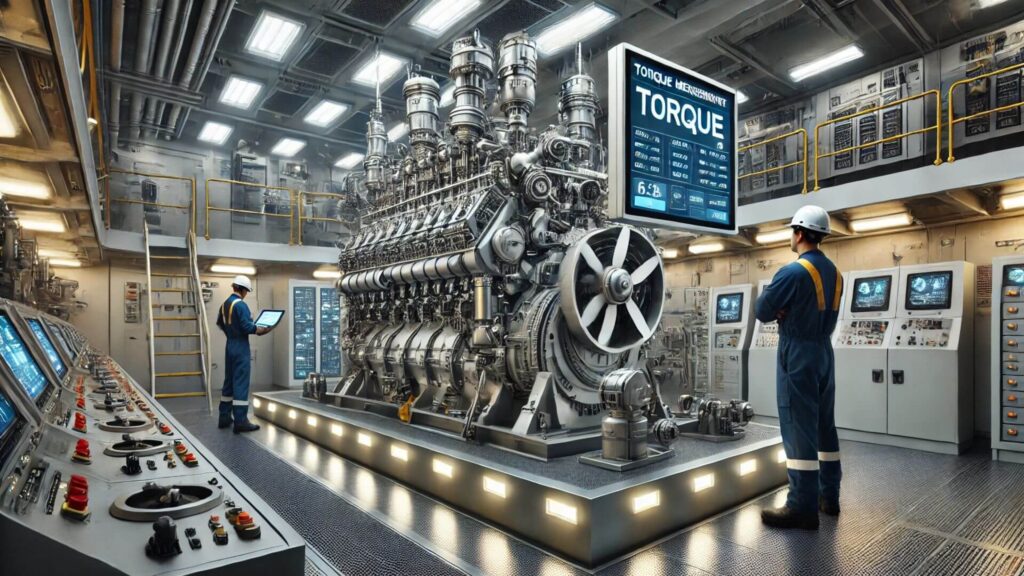
Torque measurement tools and technologies are vital in ship engine maintenance as they provide accurate torque data, enabling better engine performance and efficiency. These tools range from simple, handheld devices to complex, integrated systems.
Among the most commonly used are torque sensors, torque meters, and torque transducers, all of which can deliver real-time data on torque performance. More advanced systems may also incorporate telemetry to transmit data wirelessly for remote monitoring and analysis.
Importance of Regular Torque Monitoring for Preventive Maintenance
Regular torque monitoring is key to preventive maintenance. By consistently tracking torque output, ship operators can identify deviations from optimal performance, which may indicate potential issues. Early detection of these problems allows for timely corrective measures, preventing more severe damage and costly repairs. Regular torque monitoring ensures fuel efficiency and engine longevity, contributing to safe and efficient maritime operations.
Common Challenges in Torque Measurement and How to Overcome Them
While torque measurement is crucial, it can present several challenges. These include issues related to environmental factors, such as temperature and humidity, mechanical disturbances, and inaccuracies in data collection. To overcome these:
- Use Robust and Durable Measurement Tools: Opt for tools designed to withstand harsh marine environments. This will help ensure reliable and accurate measurements even in challenging conditions.
- Calibration: Regular calibration of measurement tools can ensure consistent accuracy. This involves fine-tuning the tools to maintain their precision and reliability over time.
- Utilize Advanced Technologies: Incorporating technologies like wireless data transmission and digital signal processing can help reduce mechanical disturbances and improve accuracy. These advancements enable real-time data collection and analysis, enhancing efficiency and reliability.
- Implement Safety Protocols: Adhering to safety protocols, such as wearing appropriate protective gear, can ensure accurate data collection and prevent potential accidents. Prioritizing safety not only protects individuals involved but also maintains the integrity of the measurement process.
- Seek Professional Assistance: When in doubt, it is always best to seek professional assistance from qualified technicians or engineers with torque measurement and engine maintenance expertise. Their knowledge and experience can provide valuable guidance and ensure optimal performance and accuracy in measurement processes.
Integrating Torque Monitoring into a Comprehensive Maintenance Strategy
Integrating torque monitoring into a comprehensive maintenance strategy involves the following:
- Establishing regular monitoring intervals.
- Setting benchmarks for optimal torque performance.
- Devising a procedure for interpreting and acting on the collected data.
This strategy should also include regular inspections and maintenance of the torque measurement tools.
By establishing such a routine, ship operators can maintain their engines at peak performance, ensuring safe and efficient operations at sea. At the same time, regular torque monitoring can help identify potential issues before they become costly, saving time and money in the long run.
Safety Implications of Torque Variations
Fluctuations in torque can have significant implications for a ship’s stability. Torque changes directly influence a vessel’s speed and direction, with inadequate or excessive torque leading to potential instabilities. For instance, sudden changes in torque can cause abrupt speed changes, making it challenging to control the vessel, particularly in adverse conditions. This unpredictability risks not only the cargo and vessel but also the crew’s safety.
Safety Concerns Associated with Inadequate or Excessive Torque
Safety concerns associated with inadequate or excessive torque largely revolve around control and power. Insufficient torque can lead to the inability to maintain the required speed or overcome adverse conditions, such as strong currents or winds, which could endanger the ship and crew. On the other hand, excessive torque can lead to overly rapid acceleration or deceleration, resulting in instability and increased risk of accidents.
Sample Incident Related to Torque Issues
Historically, several incidents have highlighted the critical role of torque in maritime safety. For instance, in 2007, the container ship ‘MSC Napoli’ experienced engine failure due to excessive torque caused by high waves and adverse weather conditions. This led to a catastrophic hull failure, resulting in the evacuation of the crew and eventual beaching of the vessel.
Best Practices for Ensuring Safety through Proper Torque Management
Maintaining proper torque in ship engines is not just a matter of performance but also of safety. Understanding and implementing best practices for torque management can significantly reduce the risk of accidents, enhancing the safety of maritime operations. To ensure safety through proper torque management, several best practices can be adopted:
- Regular Monitoring and Maintenance: Routine checks of engine performance and torque output can help detect and rectify any issues promptly. Utilizing reliable torque measurement tools can play a crucial role in this.
- Use of High-Quality Parts and Fuel: The quality of engine components and fuel can significantly impact torque output. Investing in high-quality parts and clean, efficient fuel can help maintain consistent torque.
- Proper Training: Crew members should be adequately trained to understand and manage the torque output of their vessel’s engines. This includes knowledge of adjusting and optimizing torque according to the prevailing conditions.
- Safety Procedures: Implementing and adhering to safety protocols can help manage the risks associated with unexpected torque fluctuations. This should include emergency procedures, such as sudden engine failure or loss of control due to torque issues.
- Regular Inspection and Maintenance of Tools: Proper maintenance of torque measurement tools is crucial for ensuring accurate and reliable data. Regular inspections can help detect any issues and ensure the tools are functioning correctly.
Torque plays a vital role in ship engines, impacting performance, efficiency, and safety. Utilizing robust measurement tools, incorporating advanced technologies, implementing safety protocols, and seeking professional assistance.
Torque Maintenance Practices
Torque maintenance in ship engines is critical to overall maritime safety and efficiency. By incorporating robust torque maintenance practices, ship operators can mitigate the risks associated with torque fluctuations and optimize engine performance. These practices should be proactive, involving collaboration with manufacturers, regular inspections, crew training, and a comprehensive maintenance schedule.
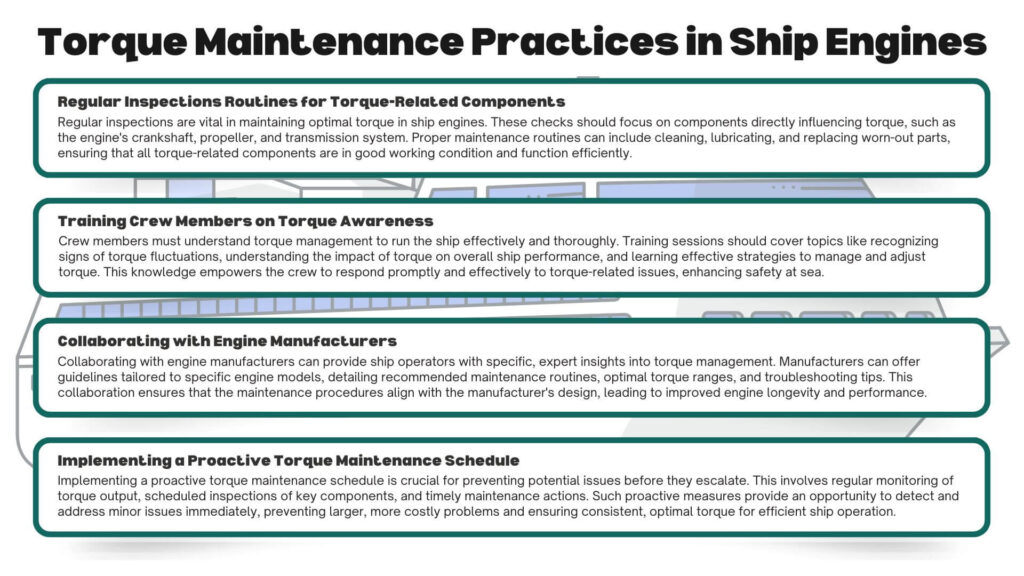
Regular Inspection Routines for Torque-Related Components
Regular inspections are vital in maintaining optimal torque in ship engines. These checks should focus on components directly influencing torque, such as the engine’s crankshaft, propeller, and transmission system. Proper maintenance routines can include cleaning, lubricating, and replacing worn-out parts, ensuring that all torque-related components are in good working condition and function efficiently.
Training Crew Members on Torque Awareness
Crew members must understand torque management to run the ship effectively and thoroughly. Training sessions should cover topics like recognizing signs of torque fluctuations, understanding the impact of torque on overall ship performance, and learning effective strategies to manage and adjust torque. This knowledge empowers the crew to respond promptly and effectively to torque-related issues, enhancing safety at sea.
Collaborating with Engine Manufacturers
Collaborating with engine manufacturers can provide ship operators with specific, expert insights into torque management. Manufacturers can offer guidelines tailored to specific engine models, detailing recommended maintenance routines, optimal torque ranges, and troubleshooting tips. This collaboration ensures that the maintenance procedures align with the manufacturer’s design, leading to improved engine longevity and performance.
Implementing a Proactive Torque Maintenance Schedule
Implementing a proactive torque maintenance schedule is crucial for preventing potential issues before they escalate. This involves regular monitoring of torque output, scheduled inspections of key components, and timely maintenance actions. Such proactive measures provide an opportunity to detect and address minor issues immediately, preventing larger, more costly problems and ensuring consistent, optimal torque for efficient ship operation.
Emerging Technologies and Innovations in Torque Management
Advanced technologies are revolutionizing the maritime industry, particularly in torque management. These innovations enhance torque measurement accuracy, optimize engine performance, and improve maritime safety. They are propelling us into a future where torque-related issues are detected and resolved promptly, minimizing risks and enhancing efficiency. Here are some notable technologies and innovations in torque management:
- Torque Sensors: These are designed to provide real-time data on torque output, enabling ship operators to make informed decisions.
- Smart Propellers: These come with embedded sensors that gather data to help operators optimize torque and improve fuel efficiency.
- AI-Powered Predictive Maintenance: AI technology can analyze torque data and predict potential issues before they become critical.
- Torque Monitoring Systems: These combine multiple sensors and advanced software to monitor torque output from various components, providing a comprehensive picture of engine performance.
- Remote Torque Management: This technology allows for real-time remote monitoring and adjustment of torque, improving efficiency and reducing the need for on-site maintenance.
Potential Future Developments in Torque Technology and Their Implications for Safety
The future holds exciting prospects for torque technology, with developments poised to dramatically enhance maritime safety. Innovative technologies, like AI and machine learning, promise to transform how torque is managed, providing predictive insights and automated adjustments. These innovations could significantly reduce the risk of torque-related accidents, leading to safer seas. Here are some potential future developments:
- Automated Torque Management Systems: Advanced systems automatically adjust torque to optimize performance and safety.
- IoT-Integrated Systems: IoT technology can enhance real-time data collection and analysis, enabling quick detection and resolution of torque issues.
- Machine Learning Algorithms: These can learn from past data, predict potential torque issues, and suggest preventive measures.
- Autonomous Torque Adjustment: AI-powered systems that can make real-time adjustments to torque, reducing the need for human intervention.
- Torque Optimization Software: Advanced software solutions automatically optimize torque based on weather conditions and vessel weight distribution.
Recommendations for Staying Updated on the Latest Torque Management Trends
In an ever-evolving industry like shipping, staying abreast of the latest trends in torque management is crucial. Innovations are constantly emerging, promising to enhance safety, performance, and efficiency. By staying updated, ship operators can leverage these developments to optimize their operations. Here are some recommendations to stay updated:
- Attend Industry Conferences and Webinars: These events often showcase the latest trends and technologies in torque management.
- Subscribe to Industry Publications and Newsletters: These regularly update recent innovations and advancements.
- Engage with Online Maritime Communities: Discussion forums and social media groups can provide valuable insights and updates.
- Network with Industry Professionals: Attend networking events and connect with industry professionals to learn about the latest trends.
- Collaborate with Torque Technology Providers: Engage with torque technology providers to understand their latest developments and how they can benefit your operations.
Frequently Asked Questions (FAQs)
Q1: What are the signs of excessive torque in a ship engine?
Excessive torque may manifest in several ways. Typically, you might notice a sudden increase in fuel consumption, overheating, unusual engine vibrations, or a significant speed reduction. These signs can indicate that your ship’s engine is operating outside its optimal torque range, potentially causing damage to the engine and reducing its efficiency.
Q2: How does temperature impact the torque of a ship’s engine?
Temperature can significantly impact the torque of a ship’s engine. Cold temperatures can increase the viscosity of the engine oil, thereby increasing the resistance within the engine and reducing torque. Conversely, extremely high temperatures can lead to overheating, which can also diminish torque and potentially cause engine damage. Therefore, maintaining an optimal engine temperature is critical for optimal torque output.
Q3: How is the torque for ship engines measured?
Torque for ship engines is typically measured using specialized devices called torque meters or torque sensors. These devices are installed in the engine’s driveline and measure the twisting force produced by the engine. The data collected by these sensors is vital for monitoring the engine’s performance, ensuring fuel efficiency, and avoiding engine damage.
Measure Torque with DATAMYTE
DATAMYTE, a recognized industry leader in providing robust data collection and low-code quality management solutions, offers a range of torque products designed to enhance accuracy and efficiency in various manufacturing environments.
LightStar™ Torque Wrench
This precise torque-measuring instrument is designed to eliminate false readings that are difficult to detect. The LightStar™ Torque Wrench series technology sensor ensures that the operator can pull at any point on the wrench and will receive an accurate measurement.
DataMyte Torque Solution
This solution provides real-time reporting and torque data collection to improve and monitor torque continuously. It’s a comprehensive system for managing all aspects of torque control, from data collection to analysis and reporting.
New Generation of Digital Torque Wrenches
DATAMYTE has introduced a new generation of their LightStar™ Carbon Fiber Torque Wrench. These digital torque wrenches offer improved performance and accuracy, making them ideal for demanding industrial applications.
These products are part of DATAMYTE’s commitment to providing quality management solutions that enhance actionable results based on collected production data. They are designed to ensure consistent, reliable torque application, improving the quality and reliability of assembled products. Book a demo with us now to see how we can help you achieve your torque accuracy goals.
Conclusion
In conclusion, the importance of understanding and managing torque in ship engines cannot be overstated due to its significant impact on safety, performance, and fuel efficiency. From the signs of excessive torque to the influence of temperature on torque and the technology used to measure it, these key points highlight the depth and breadth of considerations surrounding torque in maritime engineering.
As ship operators and engineers, it is crucial to prioritize and manage torque awareness effectively, leveraging the latest innovations and developments in torque management. As maritime engineering continues to evolve, so will the methodologies and technologies in torque management.
This ongoing evolution, fueled by advancements such as IoT, machine learning, and AI, holds promise for safer, more efficient seas. Therefore, staying abreast with these developments and implementing them in operations is pertinent to facilitate safer and more efficient voyages. Remember, in marine propulsion, torque is not just a concept – it’s a critical navigational tool.

